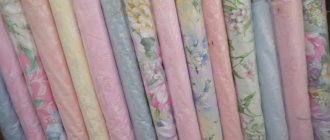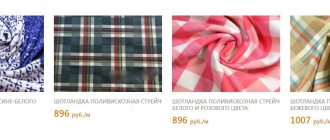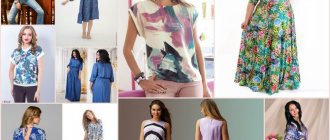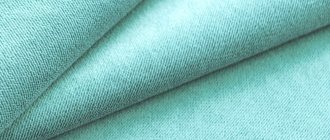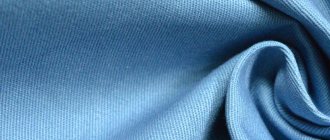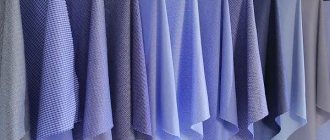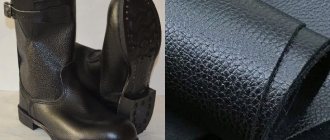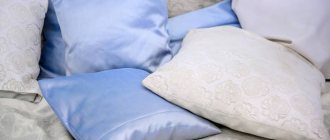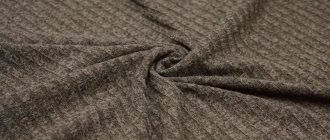This amazing material allows you to create not only luxurious models of evening dresses, but also magnificent everyday items, as well as formal and unusual interiors in any style.
Taffeta was popular in the Byzantine Empire, and then in most European countries in the 19th century, when using crinoline. It was from this material that it was possible to create voluminous silhouettes and spectacular draperies.
Description and characteristics
Taffeta fabric has a plain weave and is made from tightly twisted warp and weft threads, due to this it has the following properties:
- high dimensional stability;
- good water repellency;
- excellent drapability;
- high strength;
- durability;
- high shedding of threads;
- glossy shine.
What is taffeta?
Taffeta is a variation of a dense glossy fabric with a fine weave. In the manufacture of the material, tightly twisted threads are used, due to which the unique qualities of the material are achieved.
Ancient Persia is considered to be the birthplace of taffeta. Even then, this material was held in high esteem by the rich. This fabric was made by hand from real silk threads, which, in principle, determined its high cost. Over time, the attitude towards her has not changed.
Natural matter is still very expensive to this day. However, today there are good synthetic analogues on the market.
They are more affordable, although they are not inferior in appearance to their counterparts, have a rich palette of colors, are able to create spectacular folds, but at the same time they require more meticulous care and have a shorter service life.
Depending on the raw materials used, taffeta for curtains can be:
- Silk. That is, made from fiber that is extracted from the cocoon of the silkworm. This fabric has an expensive price, which is justified by the best consumer qualities: environmental friendliness, hypoallergenicity, wear resistance, and the ability to absorb moisture from the air.
- Cotton. Made from plant fiber. It has the same qualities as silk taffeta.
- Viscose. Made from artificial material – regenerated cellulose. Its price is strikingly different from the cost of natural matter. However, it is less wear-resistant and inferior to the previous ones in tensile strength, which is very noticeable in a wet state.
- Acetate. Made from synthetic materials. It is cheap, but its weak side is its poor consumer qualities.
Related article: Instructions for installing plastic doors
There are possible options for using mixed fabric - when natural and artificial fibers are combined in different proportions in one fabric.
Depending on the color, taffeta fabric is:
- Plain. When production uses identically dyed warp and weft threads.
- Shanzhan. This material has a generous color palette. When viewed from different lighting angles, the fabric changes color, shimmers and smoothly flows from one tone to another. This effect is achieved through the use of multi-colored fibers for the warp and weft threads.
In addition, taffeta material differs in texture and can be smooth, crinkled or printed.
The head qualities and properties of matter depend on the source material. At the same time, there are a number of properties that are inherent in all types of material.
- water-repellent properties, which are achieved due to the density of the weaving;
- wear resistance - the material has high strength, due to which it does not become thinner and does not wear out over time;
- durability – careful care ensures a long service life;
- aesthetics - the fabric has a glossy shine that ennobles it. Draps well, creating tight creases. Maintains shape.
Like any other fabric, taffeta has its downsides:
- crumbles when cutting;
- shrinks after it is washed;
- wrinkles a lot, it is possible to form folds and creases that are difficult to smooth out, and requires meticulous care.
Characteristics table
| Characteristic | Indicators |
| Compound | Cotton; silk; viscose; polyester |
| Density | from 50 to 300 g/m. |
| Width | 90; 150; 280 cm |
| Weave | Polotnyanoye |
| Hygroscopicity | Depending on the composition |
| Thermal conductivity | Bad |
| Fabric shrinkage | In natural species 3-5%; synthetics do not shrink |
| Antistatic | For polyester types - no |
| Stain resistance | good |
| dimensional stability | Excellent |
| Drapability | good |
| Stretch | Absent |
| Pillability | Not exposed |
Compositions and corresponding types
Taffeta can consist of both natural fibers and synthetic and mixed fibers. Each type of composition affects the general characteristics of the fabric - drape, density, appearance.
Natural
Made from natural silk threads, it has a noble shine and beautiful appearance. This material is expensive and increasingly rare.
Cotton - made from natural, plant fiber. The fabric has the same shine but drape better than its predecessor.
Artificial
Viscose is made from fibers of plant origin - cellulose. Pleasant to the tactile sensation, wrinkles a lot.
Acetate - produced from threads of plant origin - cellulose acetate. It has a similar appearance to silk, but is cheaper.
Synthetic
Synthetic - made from polyester or polyester high-molecular compounds. This type is increasingly found in stores, due to the low cost and ease of care of the material, in contrast to natural and artificial types.
Mixed
Blended - made from synthetic and natural fibers. At the same time, the material takes the best qualities of both types. Thanks to polyester, taffeta wrinkles less and becomes more wear-resistant. Natural components in the composition give a pleasant tactile sensation.
How to care for taffeta
Taffeta is a durable and wear-resistant fabric, but it requires delicate and careful care and compliance with all necessary recommendations for its use:
- Delicate hand or machine wash at a water temperature not exceeding 30 °C using gentle gels. Powders and aggressive agents are excluded, since they can irreversibly damage the appearance of the material in just one use.
- Taffeta can only be pressed by hand, very carefully, only slightly pressing. Then you need to wrap it in a terry sheet or towel so that it absorbs the remaining water.
- Dry the taffeta indoors, away from radiators, on a flat surface, spread out, covered with a dry cotton cloth and changing it periodically.
- It is better to dry clothes on hangers and also cover them with dry cotton cloth.
- Ironing is done only from the inside out at minimum temperature.
- Taffeta clothes are stored on hangers, always in covers, and bedspreads and curtains are neatly folded. It is not recommended to use vacuum bags for storage.
Varieties
Plain (plain colored) - the warp and weft threads have the same color.
Printed - various designs are applied to the plain-dyed fabric.
Shanzhan (changing) - the warp and weft threads are painted in different colors, due to this the taffeta shimmers when the lighting angle changes.
Types by texture
- Smooth - with a regular plain weave, it has a slight sheen.
- decorative - with various volumetric finishes in the form of appliqués, sequins or other decorative elements.
- Crash - a compressed surface is achieved by thermal pressing.
Advantages and disadvantages
Like any material, this one has its positive qualities and negative sides. Other properties may depend on the type of fiber and weaving method, but there are also unifying features:
- The tight fit of the threads does not allow water to pass through, so the fabric does not absorb moisture.
- During wear, the material retains its original appearance for a long time, the density and pattern are not erased.
- If you properly care for taffeta, the product will last for many years.
- The texture and texture of the fabric allows you to make any things from it, as it can be easily draped and processed.
Features of the fabric
There are also minor shortcomings that are inherent in the fabric:
- During the cutting process, the threads fall off.
- May shrink in size as a result of washing.
- Textiles require delicate and careful care.
- Due to the special weaving, it wrinkles quickly and is difficult to smooth out.
- Fabric made from natural materials is easily flammable and difficult to iron.
Features of the use and care of the material
It is these shortcomings that are the reason that many choose only festive dresses made of taffeta and try to avoid things made of such material in everyday wear.
Taffeta material is popular because of its unique appearance and properties that are inherent in it. There are also negative properties - difficulties in care, problems in the cutting process, high price. But many designers use fabric as the basis for evening and wedding dresses.
Where is it used?
Thanks to its properties, taffeta can be used to model three-dimensional shapes without adding weight to the structure. Therefore, products made from it look spectacular and airy.
Both wedding and everyday dresses are made from taffeta. Due to their properties, products made from the material look very luxurious. Also, this fabric has found its application in curtains; thanks to its characteristics, taffeta curtains look very elegant.
Taffeta curtains
Taffeta in the interior is a universal material; it is used both for making drapes and curtains. Sensual, light and airy - these epithets best describe taffeta. It is extremely attractive, the play of color, playing in the light, and the glossy shine make it chic. And silk taffeta curtain fabric creates an elegant and formal interior.
Curtains
Taffeta curtains and drapes look great in bedrooms and guest rooms, the office and the kitchen. This material is often used in the design of window openings in country houses, where it helps create a feeling of luxury and comfort, filling rooms with warmth and playful tints. Of course, a properly selected design plays an important role in the design.
Related article: Decorative false fireplace made of plasterboard
After all, classic tailoring of curtains will not be appropriate in every kitchen, but Roman taffeta will be appropriate if it is one-color and quite dense. For the sleeping area, the traditional option using two layers is preferable, where the densest fabric is taken as the basis, and the second layer is made of light silk. If the design of the living room is classic, then curtains in pastel colors will be the solution. Taffeta curtains look good in the interior of a study if they are made of thick synthetic fabric.
Today, stores offer taffeta curtains of various colors: from bright colors to pastel shades with a metallic shimmer or solar sheen, single-color and chameleon.
What to consider when cutting
If you decide to use taffeta to realize the desired model, do not forget what kind of fabric this noble taffeta is! It requires special treatment when cutting, sewing and further use of the product.
When cutting, the details of a paper pattern must be pinned to the fabric only with very sharp tailor's pins. Immediately after cutting, you need to iron non-woven strips cut on the bias to the seam allowances. This will prevent the threads from moving apart in the seams.
When sewing parts, use only sharp needles No. 70 or 80 and polyester threads. Stitch length 2 – 2.5 mm.
Expert opinion
Alyona
Fabric expert and technologist Alena Khlebnikova is ready to answer your questions.
Write to us
or leave feedback to our expert
Material characteristics
To understand what exactly the material is, you need to read the description of its appearance, composition and mechanical properties. The main characteristic of the material is its appearance - the canvas has a glossy shine. Additional material features:
- The fabric can be dense or thin - it all depends on the type of fiber used in weaving.
- Smooth and pleasant to the touch base of the fabric on the inside and outside.
- Does not cause irritation or allergic reactions.
- Does not magnetize and does not squint while being worn.
- Due to the dense arrangement of fibers, the fabric does not lose its original visual data for a long time.
- The canvas holds any shape remarkably well when draped.
- A variety of colors with solid and printed patterns.
You may be interested in: Appearance of flax: use of fibers
Characteristics of taffeta
Fabric of this quality requires special care, which is carried out in several stages. Additional characteristics are determined by the specific type of taffeta and its composition.


